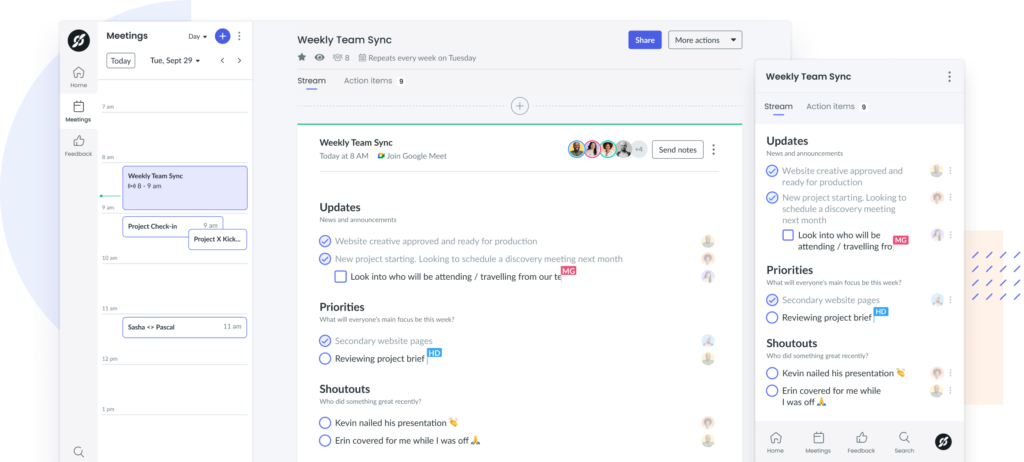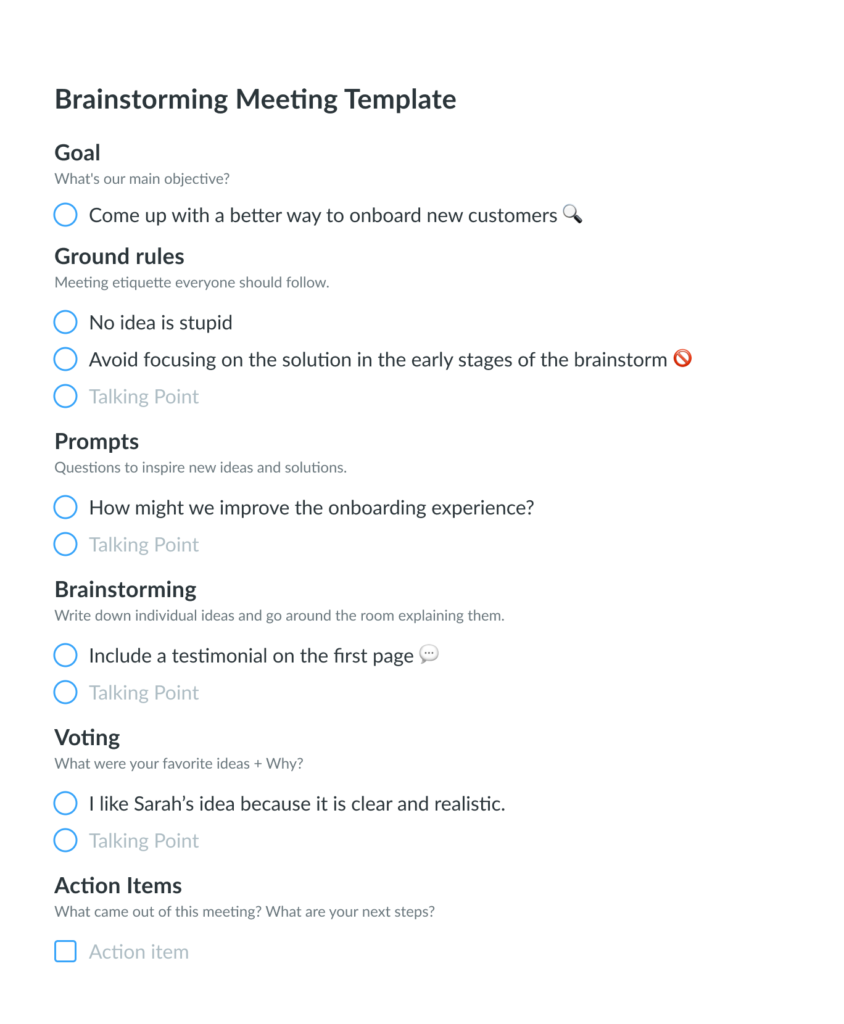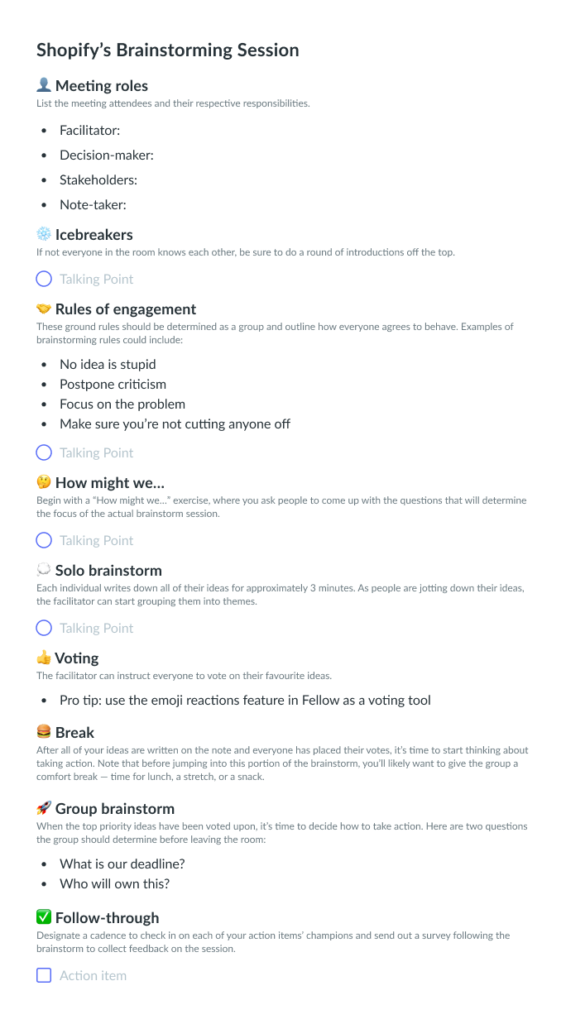How to Run a Brainstorming Meeting For The Next Big Idea
We're breaking down how to have brainstorming meetings so you and your team can collaborate on ideas and solutions.
Do you ever have a moment where you can just feel the lightbulb turning on above your brain?
Great ideas can happen at any time, but organizations have a better chance of capturing success when these ideas are cultivated inside a brainstorming meeting.
If your team is looking to solve a problem or come up with a new and creative idea, it’s in your best interest to come together and hold a brainstorming meeting.
- What is a brainstorming meeting?
- The importance of brainstorming meetings
- How to run a successful brainstorming meeting
- Brainstorming meeting templates
- 10 tips for a successful brainstorming session
- Top 8 brainstorming methods
What is a brainstorming meeting?
A brainstorming meeting occurs when people come together, either in person or virtually, to discuss, come up with, explain, or map out ideas to solve a problem or challenge they’re facing or come up with something new.
Technically, you can also have a solo brainstorming session, but a group brainstorming session is more common.
Brainstorming meetings are typically called for one purpose — to generate new and exciting ideas! All meeting attendees are expected to participate in the discussion and come up with any ideas, so be sure to let them know to show up with their creative juices flowing. It’s important to stress that no idea is too complex, simple, strange, or outside the box! The more creative ideas, the better — and you never know when an
Once your team has a solid list, consider narrowing them down or adding more details as you get closer to deciding which idea to move forward with.

Pro tip
Use a meeting management tool like Fellow to have a collaborative meeting agenda that everyone can contribute their ideas to.

The importance of brainstorming meetings
There are many different types of meetings your team can hold, but brainstorming meetings can be critical to the success of the department and the entire organization.
In addition to generating new and exciting ideas, they are also the place where team members can come together and encourage innovation. Consider this meeting a safe space for the team to build unity and develop ideas in a non-judgemental environment.
Brainstorming sessions can also bring the team together, where everyone is encouraged to contribute to the creative process. When done correctly, team members leave feeling more comfortable around their coworkers, leading to enhanced collaboration and communication on various tasks or projects down the line.
How to run a successful brainstorming meeting
If you’re interested in bringing your team together and running a successful brainstorming meeting, there are specific ways you can ensure it’s as productive as possible.
1 State the goal of the brainstorm
Before you do anything else, be sure that everyone in attendance knows the goal of coming together to brainstorm.
The best ideas will be created when the group understands exactly what the problem is they’re coming together to solve. This can be clearly stated in the agenda of the meeting you send out ahead of time. Knowing the goal ahead of time also gives session attendees time to think of ideas on their own time and come prepared with concepts to share.
For the best and most productive discussion, send the agenda with the goal clearly stated at least a few days in advance.
2 Set rules of engagement
Once the group has come together, and you’re ready to hit the ground running, take the time to go over some ground rules. These rules can be:
- Everyone is allowed to speak freely, but don’t interrupt your peers
- Don’t shy away from being your own devil’s advocate and a devil’s advocate for others
- Assign someone to be the meeting facilitator to take notes and be the timekeeper
- No idea is too crazy, so be supportive of one another
- Do your best not to go over your allotted speaking time so everyone gets their chance to share
It’s a good idea to include these rules in the agenda, too.
3 Use prompts to inspire ideas
Need a little inspiration? It’s okay if meeting attendees feel like they need a little help coming up with ideas. Consider using a prompt to get the wheels turning and the conversation flowing.
As an example, you can say something like, “with unlimited resources, time, and money, how would you solve this problem?”
Depending on how much time you have set aside, answering this scenario in a round-robin fashion can help everyone get in the appropriate headspace to come up with ideas, no matter how big or small.
4 Ask people to write down their thoughts (individually)
Before sharing ideas with the group, ask that all attendees write down their thoughts. You can facilitate this by handing out stacks of sticky notes to the group and having them write one idea on one note.
This makes it easier to organize each idea in groups or columns before the meeting comes to a close.
5 Share ideas around the room
Next, it’s finally time to share ideas with the room. Ask if any brave souls want to get things kicked off and go first. If not, go with the round-robin approach by going around the room and giving everyone a set amount of time to share what they’ve come up with.
Remember that no one is in the room to nod their head and listen to others rattle off what they’ve come up with. Everyone should participate in the conversation, provide suggestions, follow-up questions, and join the discussion.
6 Use a fair voting process
All is fair and love and war… and brainstorming sessions.
Whether you vote in the last few minutes of the meeting or after it’s come to a close, it’s time to vote on which idea prevails. A fair voting process should give employees the chance to vote anonymously on the ideas they love most.
It can be effective to conduct the voting sessions after a meeting so that all attendees have some time to think, put their feelings aside, and be as thoughtful as possible about both ideas they shared and the ones their peers brought to the table.
Brainstorming meeting templates
Now that you know the ins and outs of running a successful brainstorming meeting consider implementing one of these templates to ensure you cross your t’s and dot your i’s!


10 tips for a successful brainstorming session
Now that you know how to run a successful brainstorming session don’t forget to double-check these ten tips to ensure you’re not missing anything before you get started!
- Set a clear objective ahead of time, so the entire team knows what to expect
- Assign meeting roles so that the team can be as prepared as possible
- Start with icebreakers as a way to begin the conversation
- Clarify that no idea is stupid and that all ideas are welcome, no matter how outside the box
- Use a “how might we” exercise to determine the focus of the session to
- Avoid focusing on the solution in the early stages of the meeting
- Make sure you’re not cutting anyone off and that everyone gets the chance to elaborate on their ideas
- Give the team a break! The brain is a muscle, so in order to flex it to its full capacity, it’s okay to break for lunch.
- Designate a cadence to check in on each champion so that nothing falls through the cracks
- Send out a survey following the brainstorming to collect feedback on the session and see what improvements can be made for next time
Top 8 brainstorming methods
Unsure how to get started? Consider implementing one of these eight brainstorm methods. If you aren’t seeing much success, swap it out for a different approach.
- Brainwriting: Everyone writes three ideas down that relate to the topic, then passes the ideas to the left or right, who then has to build off that idea. Continue until ideas make it all the way around the circle and discuss ideas as a group.
- Round-robin brainstorming: Go around the entire table or room and everyone contributes one idea. Everyone must share one idea before the team works to build or elaborate on one idea.
- Step-ladder technique: The facilitator introduces the brainstorming topic and everyone leaves the room except two people, who brainstorm before another person is brought back in. Individuals return one-by-one to the room, sharing their ideas before learning which new ideas have been discussed.
- Rapid ideation: Attendees write down as many ideas as they can think of during a set amount of time.
- Figure storming: Attendees pick a well-known figure (a celebrity, a public figure, the CEO of the organization) and discuss how that individual would approach the specific problem.
- Eidetic image method: A visualization-based method where attendees close their eyes and envision an entirely new object or idea and then compare it to an actual eidetic image. The eidetic image is then used to build upon and make new.
- Brain netting: Also called online brainstorming, where team members have one central location to write down their ideas. This can be a Slack channel or a Google doc.
- Mind mapping: The group starts with one idea and then draws lines that connect sub-ideas to the main idea, which can be a great approach for visual learners.
The next big idea is right around the corner
And holding effective brainstorming meetings can put that idea within reach! Remember that no idea is too crazy, too nuts, or too dull. You never know which one will be the winner.











